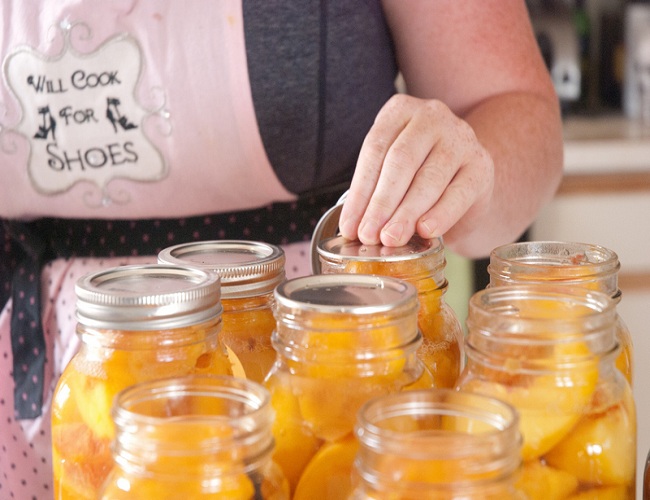With this step-by-step guide, you’ll be able to enjoy peaches all year long, even in the winter!
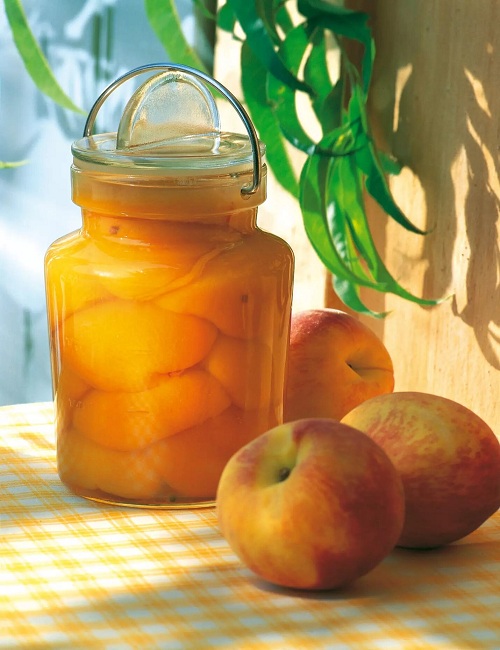
To Make 7 quarts of peaches (1 batch), you’ll Need:
- 7 sterilized quart jars with lids and rings
- Waterbath canner
- Jar grabber for the hot jars
- Peaches (around 17 lbs fresh ripe peaches)
- Sugar, honey, or juice
Which peaches are the best?
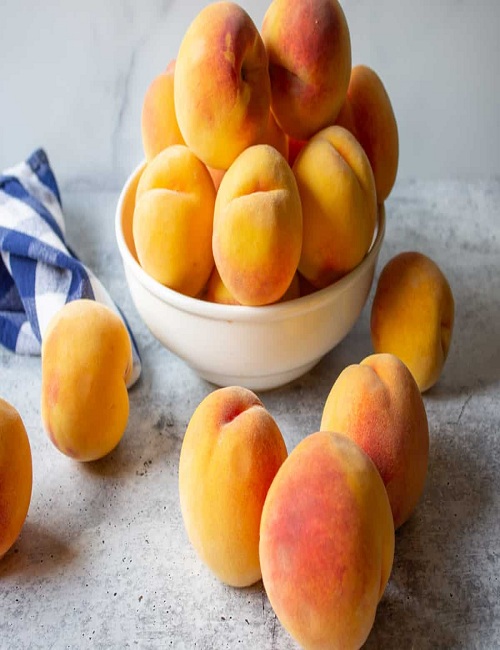
Freestone peaches are ideal for canning since the pit comes out easily, unlike “cling” stone fruits. Because cling peaches are notoriously difficult to remove the pit from, you’re likely to waste a significant amount of the fruit in the process.
White peaches are not recommended for canning because they are regarded to lack sufficient acidity. Pick large, ripe peaches that are not quite overripe. When you compress them, make sure they’re still firm but not too firm.
An Easy Syrup for Canning
When you can your own peaches, you have complete control over the sort of syrup you use and the amount of sugar you use.

The standard simple syrup ratio is 1 cup sugar to 1 cup water. However, you can adjust the sweetness level by adding less sugar or more. It all comes down to your taste and the purpose for which you intend to put it to use.
For this recipe, we recommend 2 cups of sugar + 6 cups of water.
How to Can Peaches
Get your jars ready: To ensure a proper seal, sterilize the jars and rings (I use the “bottle” cycle in my dishwasher) and buy new, unopened lids.
Prepare the water bath: Add enough water to cover the jars by 2 inches. Make sure that the water is at a rolling boil. Keep the water warm until you’re ready to add the jars, then turn the heat down.
Peel the peaches and place them in jars! Peeling peaches is easy. All you have to do is blanching them in hot water and then putting them in an ice bath. You can then start filling your jars with peach slices as you go.
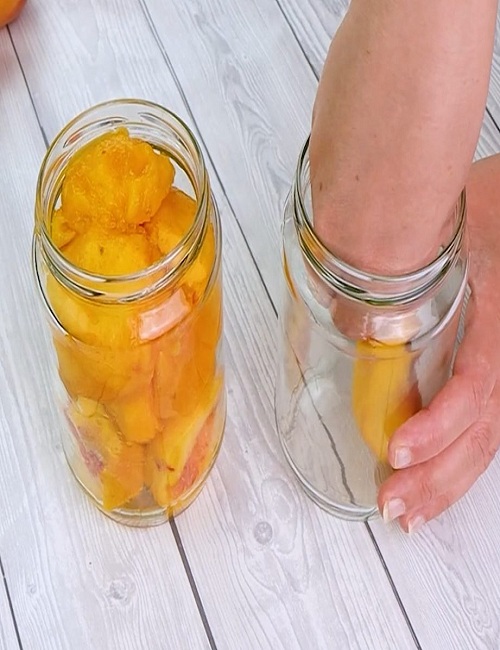
Add simple syrup: Fill each peach jar with a syrupy concoction made by combining sugar and hot water. To remove air bubbles, lightly tap the jars against a counter. Before placing the lids on the jars, make sure the rims and sides are clean.
Place the jars in the prepared canner: Lower the jars into the water bath after placing a heated lid on top and securing it with the rings. After boiling the water, process the vegetables for 25 minutes (longer if at high altitude).

Remove the jars and set them aside to cool. Put a large towel or dishrag on the counter. Remove the lid and turn off the burner after the 25 minutes are up. Allow the jars to sit for a further five minutes before transferring them to the towel to finish cooling. Before putting the jars in a dry location, allow them to cool fully.
Test and Store: After a few hours, you can tap the tops of the jars to see if the seals are intact before storing them. If the center rises and falls, the seals were not correctly applied (Refrigerate the jar and consume within a week).
Storing Tips
How long? Store your canned peaches safely once you’re done canning them. As long as the quality is good, they can be stored for up to 18 months.
Were they properly sealed? Mason jars can show signs of leaking or corrosion, which can indicate that the peaches are unsafe to eat. When you press down on the lid’s center, you should not feel it pop back up. To be safe, it should sit flat. If it pops back up, the seal has not been effectively achieved. Also, check to see that the peaches are still submerged in liquid and that their color is vibrant.
What if they didn’t seal correctly? You have several options if your peaches haven’t sealed properly. It’s up to you whether you want to consume them immediately, store them in the fridge for a few days, or process them. For water bath canning, make sure the jar isn’t cracked and then seal it again with new lids.
It’s best to throw out peaches that have a bad smell or are discolored, as these are all symptoms of spoiling and should be thrown away!
Hot Pack vs. Raw Pack
This recipe uses the raw pack method of canning, in which jars are filled with raw peaches instead of hot, cooked peaches, as is done in the hot pack method.
In both methods, the hot syrup is added to the jars after the peaches have been put in.
While raw packing is quicker and easier, it has the potential to produce fruit that floats (fruit that floats to the top of the jar after processing).
It is believed that canning fruit in a hot pack environment enhances the color and preserves the freshness of the fruit for a longer time period. Because you have to work with hot peaches and liquid, hot-packed canning takes a little longer. It also requires an additional five minutes of processing time. See the following recipes for variations on the hot pack approach.
Hot packing is required if you can the peaches without adding additional sugar (such as a simple syrup, honey, or juice).
Recipe Variations
Hot Pack Canning: Using the hot pack method, heat the 6 cups of water in a big pot before stirring in the sugar in step 7 of the recipe card. Mixture is brought to a boil, then simmered and sliced pieces are added. After 5 minutes of simmering, use a slotted spoon to ladle the hot peaches into the jars. Follow the rest of the instructions and pour in the heated syrup.
Freeze Peaches: One of the best ways to preserve fresh peaches is to freeze them, which is a terrific alternative. Using a freezer-safe bag or container, you can keep peaches for five to six months once they’ve been peeled and chopped. Frozen yogurt and smoothies are great ways to incorporate peaches into your diet.
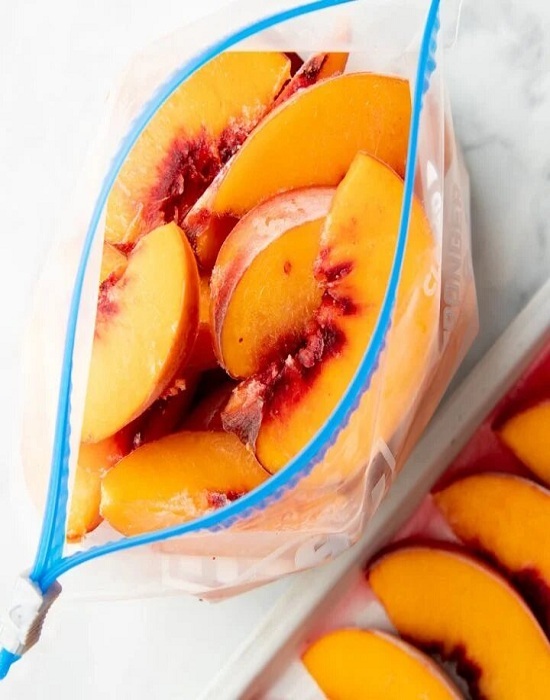
Add Cinnamon: Before adding the peaches, lay a cinnamon stick in the bottom of each jar to give it a delicious cinnamon flavor.
Add Vanilla: When heating the simple syrup, consider adding a vanilla bean pod (slit and seeds removed) for an extra vanilla kick. Remove it before drizzling peach juice over it.
Substitute Sugar for Honey or Juice: Substitute sugar for honey or juice: The ratios to use for substituting honey or juice in this recipe is shown in the image above.

